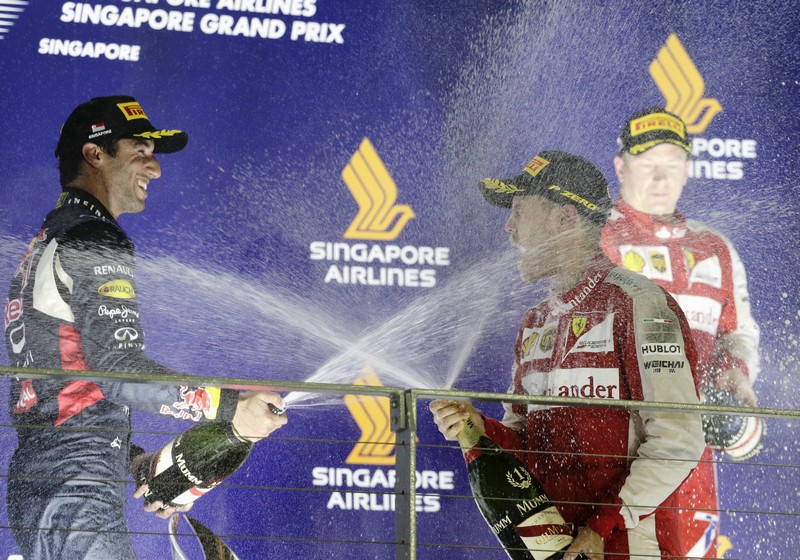Sebastian Vettel picked up a third victory in his debut season with Ferrari as championship leader Lewis Hamilton was forced to retire from the race due to engine problems, while a trespasser on the track caused a stir at an eventful Singapore Grand Prix.
Vettel led the race from start to finish in a dominant showing ahead of Red Bull’s Daniel Ricciardo and Ferrari driver Kimi Raikkonen, while the safety car was twice called into action – on the second occasion as a result of a spectator found wandering along the side of the Marina Bay Circuit.
With Hamilton’s Mercedes teammate Nico Rosberg finishing fourth, Hamilton’s lead at the top of the standings is now 41 points, while Vettel sits just eight points behind Rosberg in third.
Tunnel vision
The continued use of windtunnels for testing the aerodynamics of Formula One cars was put in doubt at the Formula One Strategy Group meeting ahead of the Singapore Grand Prix.
The proposal to introduce greater reliance on Computational Fluid Dynamics (CFD) software to help with solving fluid flow problems at the expense of windtunnel testing was voted for by a majority at the meeting. The full plans are yet to be laid out, should the ban on windtunnel testing go ahead, but McLaren Formula One team racing director Eric Boullier has backed the switch to CFD systems, so long as they are updated.
Boullier said: “On the CFD topic there is a lot of discussion for months about the regulation. It appears this teraflop restriction has pushed the engineers, as usual, to go to the limit of the regulations and we basically had to use some old chips. The consequence of this is we are not using the latest technology in terms of computing.
“We don't think it's good for Formula One to use ten-year-old technology – we are supposed to be at the top. Some discussions have taken place about changing the regulation from this teraflop story to an energy bandwidth control. This would allow more freedom for the teams to do what they want with their computers, but still being regulated, the same with the FIA. That's something we are very much in favour of, because it would be right for F1.
“Then on the windtunnels if you allow the CFD development maybe one day windtunnels could be obsolete. We would be happy to implement [the new technology] as soon as possible.”
The windtunnel ban does not have the support of either Mercedes or Williams F1 teams though, with Mercedes chief Toto Wolff saying: “We are a road car manufacturer and we have just commissioned a brand new windtunnel in Stuttgart. How can you operate at the pinnacle of motorsport and not use one of the finest tools in aerodynamics? It doesn't make any sense to us.
“A windtunnel is needed today to put a car on the street, verify what's being done in CFD and to get correlation.”
Williams currently has two windtunnels at the team’s headquarter in Grove, UK, and deputy team principal Claire Williams commented: “We absolutely do not and will never vote for the banning of windtunnels in Formula One.”
Another motion to reduce costs in F1 given backing at the Formula One Strategy Group meeting was a cost cap for engine-supply deals to customer teams. With current figures showing that teams are spending between UK£15-20million per season on the 1.6-litre turbocharged V6s, which were introduced in 2014, the proposal will see current-spec engines costing €12 million (UK£9 million), with one-year-old spec engines set at €8 million (UK£6 million).
Among the other proposals at the meeting was a €2 million (UK£1.5 million) cap on gearboxes, and these must all now await clearance by the F1 Commission, and subsequently, the FIA World Motor Sport Council, which is set to meet in Paris on 30th September.
Supply and demand
Meanwhile, Boullier has suggested Honda could be set to supply engines to a different Formula One team from the start of the 2017 season.
Japanese manufacturer Honda returned to F1 this year as the engine supplier to the McLaren team, and when asked ahead of the Singapore Grand Prix whether any additional teams could join McLaren on Honda’s supply roster, Boullier said: “You all know that in the current agreement for an engine manufacturer to enter Formula One there is the possibility to supply other teams. It's a question we have discussed already and we keep discussing with Honda.
“And at the right time for our partnership we would be ready – Honda would be ready, yes – to supply another team. We are partners, we are discussing, and we will agree when we do it.”
Lotus given reprieve
The Lotus Formula One team’s expected deal with Renault has been given some breathing space after a high court ruling granted them a week to seal the deal.
The proposed offer from Renault for a 65 per cent ownership of British-based Lotus, worth around $100m (UK£64m) to be paid over ten years, has been awaiting the adjournment of a case brought against Lotus by HMRC, the UK tax authorities, over unpaid income tax and national insurance.
Lotus now have until 28th September, the day after the Japanese Grand Prix at Suzuka, to complete the deal or face entering administration. At present, Luxembourg-based owners Genii are covering the costs of keeping the team running.

